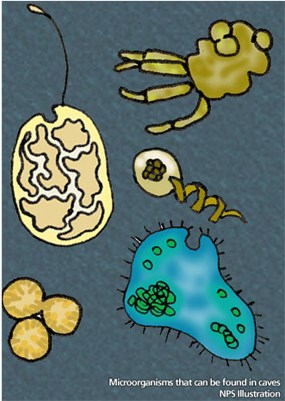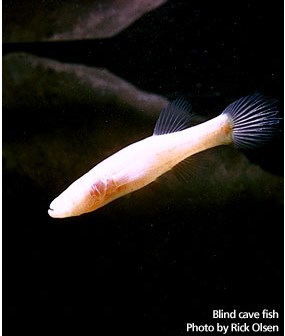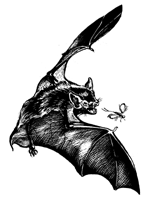What Kind Of Animals Live In A Cave
Unlike the surface environment that is very changeable, cave environments are constant. Information technology is a earth of total darkness, constant temperature and high humidity. The animals that live in caves must not simply adapt to these conditions, they must live in an environs where at that place is very lilliputian to swallow.
The population of animals living in caves is very small compared to the animate being life on the surface. Consequently, a number of cavern animals are on the endangered species listing. This means that they are in danger of becoming extinct.

The Cave Food Chain
All life depends on sunlight, even in the darkest areas of a cavern. No green plants grow here because they need light for photosynthesis. On the surface, light-green plants make nutrient. Cave animals must depend on occasional floods to wash leaves, twigs and found debris into the cave. Another nutrient source is provided by droppings from animals that go outside to feed then render to the cave to sleep or raise their young. The droppings from animals, such as bats and crickets, may provide the only major food source in some caves. Few animals can straight feed on these droppings. Instead, bacteria and fungi decompose these materials into simple foods and nutrients.
Fungus-eating insects, such equally beetles and mites, feed on the fungi and leaner on animal droppings and plant debris. These animals then get the food supply for the larger predators similar salamanders or crayfish. The droppings from larger cave animals replenishes the food supply for fungus and leaner. Thus the food concatenation continues.
All species in the cave system are dependent upon each other for survival. Call up, the number of animals in a cavern is far fewer than their relatives on the surface. For these reasons we call back: DO NOT DISTURB life within a cave.

Rick Olsen, NPS
Types of Cave Life
Cave animals fit into three categories based on the amount of time they actually spend in the cave.
Trogloxenes: from the Greek words "troglos" (cave) and "xenos" (invitee). They are temporary cave residents which freely move in and out of the cave. These cave visitors seek out such a habitat from choice, and never complete their entire life wheel in the cave. Bats are normally the first trogloxenes that come up to mind. Some species adopt the constant temporature of caves for hibernation and to acquit their young. Bats, bears, skunks, moths, and people are examples of trogloxenes. Many of these animals are not dependent on the cave for their survival, they prove no special adaptations to the cave environment.
Troglophiles: from the Greek words "troglos" (cave) and "phileo" (love). These cavern loving animals can live in the night zones of a cavern, or they can also survive outside the cavern. At times they volition venture out in search of nutrient. This group includes earthworms, some beetles, cave crickets, frogs, salamanders, and some crustaceans (such equally crayfish).
Troglobites: from the Greek words "troglos" (cavern) and "bios" (life). They are the true cave dwellers which spend their entire lives in the cavern. Living permanently in the dark zone, these species are found just in caves and cannot survive outside the caves.
Troglobites have adult special adaptations to help them survive in caves. Since cave food sources are meager, the sense organs and physical resources of troglobites are devoted to finding food. Sense organs and concrete adaptations that are beneficial to the animals' survival are enhanced. Sense organs that are not necessary have degenerated.
Virtually troglobites are white to pinkish in colour. They lack paint (color) considering they have no need for protection from the sun's rays or for cover-up to hide them from predators. Many have no optics or eyes that are poorly developed. Eyes are not necessary considering of the lack of lite. Since eyes require food free energy to maintain, and are very prone to injury, an eyeless cave fish tin survive longer with less food than a fish that has optics.
What the troglobites have lost they make upward for with longer legs and antennae, or feelers, and with adaptations that enable them to go for long periods of time with little food. Animals that have completely adjusted to cavern life include: cavern fish, cave crayfish, cave shrimp, isopods, amphipods, millipedes, some cave salamanders and insects.

Michigan Section of Natural Resources
The Big Story: Bats
What animate being can fly with its hands, "see" with its ears, and sleep hanging upside down? Your friendly neighborhood bat. Bats are tiny mammals that are often feared past many people. Bats are one of the most misunderstood animals. The truth is that bats are gentle, intelligent animals that are quite timid when information technology comes to interacting with humans.
Did yous know that bats are the but truthful flying mammals in the world? They are one of the nigh numerous and diverse orders of mammals. The total world population of bats is more than ten billion. Most i,000 species are recognized. In the Usa, there are over twoscore species of bats working to go on mosquitoes from bugging y'all.
Cavern bats range in size from iii to five inches long, with wingspans between eight and 13 inches. Most bats in Missouri have wingspans of less than five inches. The wing of a bat is actually a hand. (Bats are of the order Chiroptera, Latin for "hand fly.") The wing is composed of the forearm and extended "fingers" of the mitt. The tertiary, 4th, and fifth fingers, or digits, of the hand support most of the wing membrane. The thumb is a tiny hook on pinnacle of the wing. The wing membrane connects with the body, dorsum legs, and, in most bats, encloses the tail. Cave bats weigh very footling, less than an ounce.
Bats can live up to 25 years and normally have only ane young each year. Equally with other mammals, the infant bat is born alive and is fed milk by the mother. Females often nest in large colonies. They roost in caves during the 24-hour interval, preferring dome shaped ceilings for safety from predators. Roosting bats hang by their feet with their wings folded around them. Bats not only roost in caves, just too in attics, towers, and other man-made structures; some species even live in copse.
Many people retrieve that bats are dingy and carry diseases. Bats are actually make clean and almost affliction-free animals. And yet, people are concerned that all bats behave rabies. This misconception began over forty years ago when inadequate testing procedures institute that all bats tested positive for rabies. Subsequently amend testing procedures were developed, it was constitute that bats carry a harmless virus that gave the same reaction equally the rabies virus. Unfortunately, the damage was already done and this peaceful little creature was labeled as a menace to society. However, equally with all mammals, there is a possibility that a bat may contract rabies. In the United States, rabid bats are rare; less than one-half of ane percent of bats carry rabies. Many more than rabies cases can exist attributed to dogs, cats and raccoons than to bats. Every bit with any wild animal, a ill or injured bat should not exist handled!
You are most probable to see bats swirling around a streetlight as they devour your local mosquito population. Bats are the only major predator of dark-flight inects. One gray bat may eat upwardly to 3,000 insects in a single dark! In Texas, there is a colony of Mexican free-tailed bats that eats more than 250,000 pounds of insects every night!
Bats feed at night, catching insects such as moths, flying beetles, and mosquitoes. How do bats manage to steer through the darkness of night and the full blackness of caves with such ease and accuracy? They use ultrasonic sound to locate insects. Bats transport a high frequency sound that bounces off objects. They hear these echoes and locate, identify, and capture moving prey while flight through the dark. This process is chosen echolocation. Echolocation helps them navigate through the cave in total darkness. Have you ever noticed the large ears of bats? These big ears help them hear these echoes.
Source: https://www.nps.gov/ozar/learn/education/cave-biology.htm
Posted by: herrerabeinglis.blogspot.com

0 Response to "What Kind Of Animals Live In A Cave"
Post a Comment